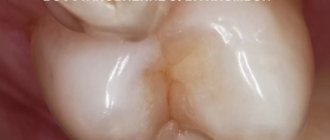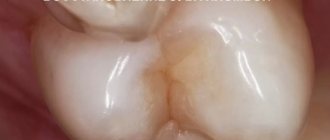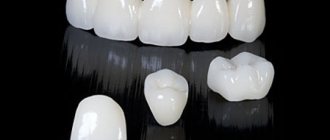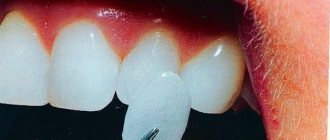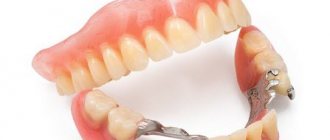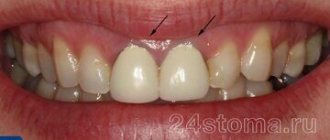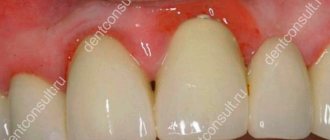The absence of 2 teeth in a row is a common defect that often occurs in patients. The problem needs to be eliminated, because the bone will atrophy, and over time it will be more difficult to solve it. Implantation is considered the best way to restore several teeth in a row, since it is the installation of durable artificial roots that will last a lifetime. On top they are covered with crowns, which completely preserve the function of chewing and recreate the aesthetics of a smile. The choice of implantation method depends on how long ago the teeth were removed and the structural features of the patient’s jaw.
Is it possible to implant 2 teeth at once?
Implanting 2 teeth is no different from restoring one tooth. Artificial roots are also placed, which are then covered with crowns. It is better to install both units at once, without dividing them by time. This will reduce the preparation time, there will be no repeated anesthesia and double antibiotic therapy, which is undesirable to carry out more than once every six months.
Implantation is usually performed using the classical method:
- Installation of an artificial root and prosthetics are separated by 2-6 months, which are needed for the implants to heal.
- First, an implant is placed, the gum is sutured, and fusion occurs with the bone tissue.
- After 2-6 months, the gum is cut, an abutment is placed, and the implant is covered with a crown.
During osseointegration, a removable temporary butterfly immediate prosthesis is worn.
How to replace teeth with missing molars: bridge
A bridge is the only applicable method of permanent prosthetics in the absence of several adjacent teeth. It consists of connected crowns, the outer ones are put on healthy teeth (close to those that are missing).
The need to grind down the supporting teeth is the main disadvantage of this type of prosthetics, which often forces patients to look for other methods. Today bridges are secured in alternative ways:
- on metal plates;
- using a special adhesive.
Crowns for bridge structures are made from the following materials;
- ceramics;
- metal ceramics;
- plastic.
For the most part, the price of the issue depends on the material from which the prosthesis is made, as well as whether it is necessary to restore one tooth or whether prosthetic teeth are needed in the absence of a large number of them. The cost of one crown in our clinic is from 15,000 rubles. for metal ceramics up to 25,000 rubles. and more for ceramics.
Plastic crowns are installed as temporary crowns. Installing crowns made of plastic on chewing teeth is not advisable - this material is not sufficiently stable, and the crown can easily break.
The service life of a prosthesis depends on the number of missing teeth it replaces: the more crowns it has, the less it will last. On average, you should expect 5-7 years of using a bridge.
Over time, bridge structures become mobile, which can lead to unpleasant consequences:
- bleeding gums;
- exposure of the neck of the supporting tooth;
- food residues getting under the structure.
Implantation of two teeth side by side
Depending on the location of two missing teeth in a row, the requirements for implants and crowns differ.
Front teeth
When installing implants in the frontal area, there are features:
- increased demands are placed on aesthetics;
- Individual zirconium abutments are used;
- if necessary, gum plastic surgery is performed;
- narrow implants are installed for a narrow frontal area;
- before the implants heal, temporary or lightweight crowns or butterfly prostheses are placed, which are attached to adjacent teeth;
- After engraftment, metal-free zirconium dioxide crowns are installed with the color most closely matched to the shade of adjacent teeth.
Chewing teeth
If there are no two teeth in a row in the lateral zone, thin short implants are not suitable for restoring such units. Wider ones are used so that they can cope with chewing loads. We use durable crowns; we install metal-free ones made of zirconium. Such prostheses last for 20 years and are fully compatible with the body. Immediate loading of the implant with crowns is not permissible, since artificial roots that have not taken root may move during chewing.
Treatment and implantation of two teeth
Attending doctor
Strigin Vladimir Igorevich
Find out the price
One-stage implantation
This version of the procedure is known as Immediate Load. The installation of crowns occurs immediately after implantation of implants and fastening of abutments. The duration of treatment is several days, but this is only relevant for those cases when there is no need to treat gum inflammation, treat or remove nearby teeth and eliminate other problems.
Key stages:
- Diagnosis of the patient’s teeth, gums and general health, testing, orthopantomogram and computed tomography examination.
- Selecting the optimal location for installing implants with the production of special templates.
- Implantation (approximately 30 minutes).
- Making impressions for the production of prostheses.
- Installation of crowns using a screw or glue.
Is it possible to place one implant on two teeth?
This is impossible, since when installing one implant with two crowns, one of them will be suspended. This will create a natural lever that will eventually dislodge the artificial root from the bone. If the dental units are small and located close to each other, there is the option of installing two mini-implants. This way the load will be distributed evenly, but this option is temporary.
Theoretically, there are possible options that we do not practice:
- If there is no central and lateral incisor in the upper jaw, then you can place one implant in the center and hang a small lateral tooth on it. This will reduce the load.
- If there are no two incisors on the lower jaw, then you can make one implant and place 2 crowns with minimal load.
- You can install one implant and place a bridge supported by it and a living tooth. But this is strictly not recommended. Living teeth are mobile, and artificial roots are firmly attached to the bone - a shock-absorbing effect will occur, which will lead to loosening of the prosthesis, dislocation of one or both supports.
In what cases is implantation impossible?
If we talk about situations where implantation on two or three teeth is impossible, then such cases also occur. They happen quite rarely. As a rule, our clinics always have the opportunity to perform bone grafting or use ultra-short implants. For example, in the lower jaw, if there are only 5-6 millimeters to the mandibular canal, which is quite small for a conventional implant, we can install an ultra-short AnyRidge implant with a large surface area. This type of implant has a thin body - only 3.5 millimeters, and a thread - 5 millimeters, and due to this design we can produce excellent implantation with a predictable result. Therefore, modern science makes it possible to place an implant even in the most difficult situations. It happens that there is no way to install an implant at all, for example, due to severe atrophy, then in this case, you can find a solution to the problem. If the gap is no more than two teeth, the remaining option is a bridge on adjacent teeth, or the use of a removable denture.
Implantation for isolated absence of 2 teeth
1 implant is placed in each defect area. The choice of shape and size of the artificial root depends on the location on the jaw - in the anterior or frontal area.
Simultaneous installation of two separate roots is feasible if the patient still has the normal ability to eat:
- defects are located on one side of the jaw;
- on different jaws, but on the same side.
Otherwise, the operation is divided over time. For example, if two teeth are missing at the same time - one is upper left, the second is lower right.
Where to go for combined dental implantation in Moscow
The benefits of using dental implants are numerous and undeniable. This is an ideal solution for both single defects and large numbers of missing teeth. Teeth restored with implants feel comfortable and look aesthetically pleasing. At the same time, the implants firmly and reliably hold the prostheses, preventing bone loss of the alveolar process. If we are talking about a lack of units in different parts of the jaws, doctors use combined dental implantation. This means that an individual system is selected for each defect - classic and basal implants are used, or complete dentures using the “All-on-4” technology.
To develop a plan for combined dental implantation, the doctor evaluates:
- Number and size of defects
- Condition of soft tissues
- Periodontal condition
- The width and height of the alveolar processes of the edentulous processes
- Level of oral hygiene
You can get advice on the possibility and cost of implants for combined implantation specifically in your case by contacting any of the dentists in Moscow that specialize in this procedure. Below are several clinics that provide these implantation services with prices for 2022.
| Name | Clinic address | Service cost |
| ROOTT |
|
|
| Shandora | Moscow, Kolpachny lane, 6, building 4. |
|
| Dentistry Grand Smile | Moscow, st. Miklouho-Maklaya 43 (metro station Belyaevo, Yugo-Zapadnaya, Kaluzhskaya) | Prices for dental implantation from 30,000 rubles (MIS system) to 70,000 rubles (Nobel) |
| Dentistry City Dent | Moscow, st. Novocheremushkinskaya, 57 | Implantation of one tooth with the Astra Tech system – 52,000 rubles |
| Dentistry Vita-Stom |
| Implantation of one tooth with the Straumann system (Switzerland) – from 32,000 rubles. |
If after implantation:
- Pain persists or worsens for several days
- The bleeding continues
- There is a persistent headache or swelling
- After 12 hours there is still no sensitivity in the affected area
- There are other circumstances that are causing you concern
In any of the above situations, immediately contact the clinic where you had the implantation.
Other jobs
Is it possible to install implants immediately after removing 2 teeth?
This method is possible. Single-stage implantation is used, in which the implant is placed immediately into the hole after tooth extraction. But the following conditions must be met:
- the procedure is planned in advance to allow for diagnostics and assessment of the operation;
- removal was carried out atraumatically, without damaging the alveolar process;
- there should be no inflammation, cysts, granulomas, purulent processes;
- the volume of bone tissue is sufficient for the implant to be securely fixed.
Question 3: Is it possible to place an implant immediately after tooth extraction?
Yes, you can. This procedure is called one-stage implantation, when a titanium root is implanted immediately after the extraction of its tooth. But there is one important condition here - the patient must have enough volume of hard bone for the pin to be successfully implanted and take root. If there is a lack of bone tissue, then most likely the surgeon will offer a classic scheme with preliminary bone augmentation.
The presence of inflammation also plays a role. If an inflammatory process is diagnosed in the area of the tooth being removed, the soft tissues are first treated, and only then preparations are made for the implantation of a new tooth.
It is important
! By saving a few months or “turning a blind eye” to inflammation, all the work to restore teeth may come to naught. It is much better to wait until the skeletal system and soft tissues are ready to accept the foreign body (and the implant is a foreign body) so that the process is completed with 100% success.
Doctor's advice - crowns can be placed immediately
For this purpose, a one-stage implantation method is used, when an implant is placed and covered with a crown on top, without waiting for its engraftment. The method is used when there is a sufficient amount of bone tissue. Used for dental units that do not actively participate in chewing. The crown is placed temporary, made of plastic or metal-plastic, and removed from the bite (lower in height) to eliminate active loads. After engraftment, it changes to permanent.
Levin Dmitry Valerievich
Chief physician, Ph.D.
Question 9: How long does swelling last after dental implantation?
Tissue swelling is a natural reaction of the body to external intervention. As a rule, a small tumor forms at the site where the pin is inserted. It can change the geometry of the face, and the tumor will be visible from the side.
As a rule, swelling appears two to three hours after surgery, and increases by the second or third day. If the operation is successful, the swelling subsides after five to seven days. It is very important to track the dynamics of swelling - if on the third or fourth day it becomes smaller, it means that the postoperative period is proceeding normally. If the tumor only grows and spreads to the neck, back, spine, this is an alarming signal! It is imperative to consult your doctor.
When is bone augmentation needed?
For implantation to be carried out flawlessly, a sufficient amount of bone tissue is required. If teeth are missing for more than a year, then in 95% of cases bone grafting will be needed due to atrophy. Osteoplasty is needed so that the implant does not damage blood vessels, nerves, and recreates normal anatomy. The strength of root fixation also depends on it.
Our Center uses the following methods:
- Sinus lifting is a bone grafting procedure performed on the upper jaw in the area of the maxillary sinus. The mucous membrane is lifted, the vacated space is filled with bone chips. Often performed simultaneously with implantation.
- Guided bone regeneration - the gum is exfoliated, bone material is added, and covered with a membrane. Implants are installed at the same time if the bone deficiency is small. Recovery takes six months.
Implantation without bone grafting is possible when, along with implantation, the process of tissue growth begins. This technology is optimal; bone growth stimulators are fixed to the neck of the implant. The procedure is low-traumatic, but expensive. Its type - autotransplantation (transplantation of bone blocks from other parts of the human body) - is not used in the clinic, because the blocks can dissolve.
The sooner the tooth is restored, the less bone loss develops, so surgery to build it up may not be necessary.
How to place implants: methods if there are no 2 adjacent teeth
It can be carried out using a classic two-stage protocol or a one-stage protocol with immediate loading.
Two-step installation
Classical implantation is carried out in two stages:
- Implants are placed into the bone. The engraftment period takes from 2 months to six months. During this period, a plug is attached to the implant to prevent pathogenic microbes from leaking into the implant area, and the gum in this place is sutured.
- Upon completion of the period of osseointegration of the implant, the doctor begins the prosthetic stage. The gum is opened, the implant plug is removed, and an abutment is installed in its place, on top of which a crown is attached.
Before installing the abutment, 7-10 days before prosthetics, an intermediate operation may be performed to install a gum former to give it the required shape.
This does not mean that the entire operation is completed in two visits. Preliminary diagnosis, treatment of dental diseases, and, if necessary, bone grafting are carried out. During the second stage, the doctor will need to make an impression.
One-step protocol
Implantation using a one-stage protocol is called Immediate Load. Immediately after the installation of implants and abutments, crowns are placed. The entire treatment period takes from several days to one week, unless there is a need to cure or remove adjacent diseased units, eliminate gum inflammation or other diseases.
Main stages:
- The dentist analyzes the condition of the gums, teeth, and the body as a whole. The patient undergoes tests, an orthopantomogram and computed tomography are performed.
- The doctor selects a place for implantation, and surgical templates are created for greater accuracy.
- The implantation procedure takes about half an hour.
- Impressions are taken to make prosthetics.
- Fixation of crowns with dental cement (glue) or screw method.
When and how to perform bone augmentation and sinus lift
After tooth extraction, atrophic processes begin in the jaw structures, so dentists recommend implantation immediately. If there is a loss of bone tissue, it will be necessary to surgically restore its volume to create reliable support for the titanium rod.
The procedure has several options:
- Sinus lift. Used to increase the volume of bone in the upper jaw by displacing the lower wall of the nasal sinus. Artificial material is placed in the resulting space.
- Autotransplantation . Transplanting a patient's bone from another area. The method is attractive because rejection occurs less frequently.
- Splitting the alveolar ridge to expand the bone.
- Artificial bone grafting.
The process of restoring the volume of the bone block lasts 4-6 months, after which implantation can be performed.
- Complete restoration of the dentition in just 4 days!
more detailsRoott Pterygoid Implants Sinus lift is no longer needed!
more details
Once and for life! Express implantation in 4 days with a permanent ReSmile prosthesis
more details
All-on-4, All-on-6, ReSmile, Zygomatic implantation We use all modern methods of dentition restoration
more details
Price
The clinic uses a case payment system. The cases are designed for installation of 1 implant. Accordingly, if two teeth are missing, the package cost will double.
The cost of the surgical stage includes:
- anesthesia;
- implant;
- plug, abutment, former;
- complex of reconstruction and basic bone augmentation;
- repeat CT.
The price of implants varies depending on the type of bone. Nobel Biocare PMC (cheaper) is intended for weak bones, and Nobel Biocare Conical Parallel CC (more expensive) is for dense bone tissue.
The cost of prosthetics includes:
- making a crown;
- taking impressions;
- installation.
Paid separately:
- tooth extraction with one-stage implantation - the price depends on the complexity (simple is cheaper, complex is more expensive);
- bone grafting or sinus lifting if necessary - the price depends on the amount of bone material and the method of osteoplasty.
Average prices in Moscow
| Name of service | Cost in rub. |
| Consultations | |
| Dentist | 600 |
| Periodontologist | 740 |
| Implantologist | 820 |
| Diagnostics | |
| X-ray of the tooth | 340 |
| Orthopantomogram | 1100 |
| Computed tomography (fragment of the dentition up to 3 teeth) | 2200 |
| Preparation period | |
| Professional hygiene with ultrasound | 2000 |
| Relief of periodontal inflammation | 2500 |
| Teeth brushing using the Air Flow method | 3500 |
| Treatment of caries | |
| Superficial | 2800 |
| Average | 3200 |
| Glubokoye | 3800 |
| Bone tissue augmentation | |
| Implantation of osteoinductive material in the area of 1 tooth | 10900 |
| Closed sinus lift | 17700 |
| Open sinus lift | 36700 |
| Implantation of two implants by manufacturer | |
| Alfa Bio (Israel) | 32000 |
| Osstem (Korea) | 40000 |
| "ROOTT" (Switzerland) | 50000 |
| MIS (Israel) | 50000 |
| Astra Tech (Sweden) | 86000 |
| Straumann (Switzerland) | 102000 |
| Nobel Biocare (Switzerland) | 120000 |
| Crowns for 2 implants | |
| Temporary | 18000 |
| Metal-ceramic | 40000 |
| From zirconium dioxide | 73200 |
Guarantees
Our Center uses implants with a lifetime guarantee - Nobel Biocare. We provide guarantees:
- 2 years for treatment;
- 1 year for prosthetics;
- lifetime for implantology.
Warranty obligations apply provided that the patient follows the doctor’s recommendations, rules of care and regularly visits the dentist. The warranty program includes a complex: for an implant, surgery, bone reconstruction and prosthetics.
Implantation of three or more teeth in a row
If several units in a row are missing in a row, fewer implants can be used for restoration. For example, install two rods and a bridge of three crowns in the jaw, the middle of which is blind. In the same way, you can restore four missing teeth in a row. This approach helps save on the cost of implantation. But along with it, the classic “implant-crown” scheme can also be used.
If all teeth in the jaw row are lost, one-stage implantation using the “All on 4(6)” method is also used. The peculiarity of this technology is the installation of a full jaw bridge on four or six implants.
Alternatives to implantation
- Dental bridge - structures in the form of welded crowns are placed in place of missing teeth. Along the edges they rest on supporting living teeth, the middle pendant teeth replace lost teeth. The method has disadvantages - grinding and depulping of supporting units, the process of bone atrophy continues, short service life in comparison with implants - up to 15 years.
- A removable denture is an artificial gum with plastic crowns. It is attached to adjacent teeth with hooks or to the gums using suction. Under such prostheses, bone atrophy progresses with greater force. In addition, it is uncomfortable for a person to chew, and long-term addiction occurs. Service life - up to 7 years.
Alternative methods of prosthetics
To replace two lost teeth, 2 types of dentures are used. Removable consists of artificial gum with crowns and hooks that secure the dental structure to healthy teeth. The fixed bridge prosthesis is fixed to adjacent supporting units.
Disadvantages of methods:
- It is necessary to depulp and grind healthy dental crowns. This leads to the development of caries and other pathologies. Due to the high chewing load on the support, the roots become loose and become less stable.
- Atrophic processes continue in bone tissue.
- Difficult care, inconvenience, low aesthetics for removable models.
- Regular inflammation of the gums is possible due to food particles.
- Chewing function is not fully restored.
- Short-lived, require regular replacement.
Removable dentures and bridges have the lowest price, but are losing popularity every year. More and more patients are restoring their teeth with implants.
Indications and contraindications for dental implantation
Dental implantation can be used in cases where one, several or all teeth are missing. Many are afraid of this technique, considering it risky. The list of contraindications is not as long as it might seem.
Absolute contraindications:
- age (the jawbone is fully formed only by 17–22 years);
- blood clotting problems;
- oncological diseases;
- osteoporosis;
- recovery after myocardial infarction;
- cardiovascular diseases in the acute stage;
- diabetes mellitus in the stage of decompensation;
- connective tissue diseases;
- alcoholism;
- diseases of the skeletal system;
- disorders of the nervous system;
- chronic liver and kidney failure;
Relative contraindications:
- bearing and feeding a child;
- active smoking;
- abnormal bite (requires adjustment);
- acute periodontitis (requires treatment);
- tartar (requires removal);
- diabetes mellitus in the compensation stage;
- bruxism.
Pregnancy and breastfeeding are relative contraindications to dental implantation for women. But doctors still recommend postponing the procedure. Women expecting a child are generally not recommended to undergo surgical interventions without special indications, especially in the first trimester, when the formation of the baby’s vital organs occurs. Implantation is performed using local anesthesia, after the operation painkillers and anti-inflammatory drugs are prescribed, and X-rays are taken before implantation. All this is extremely undesirable for pregnant women. During pregnancy, immunity is reduced, and recovery after implantation may be delayed. Breastfeeding is another reason to postpone implantation: medications are prohibited, and stress may cause milk to disappear.
